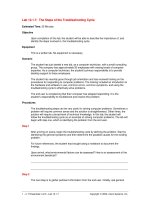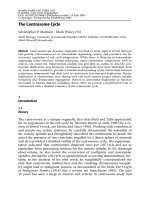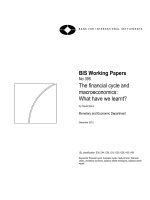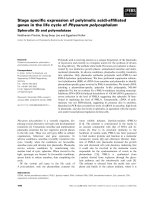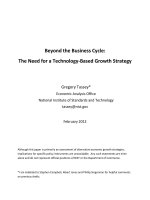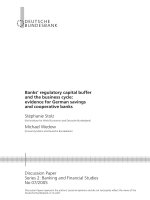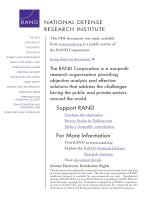The Centrosome Cycle
Bạn đang xem bản rút gọn của tài liệu. Xem và tải ngay bản đầy đủ của tài liệu tại đây (484.07 KB, 36 trang )
Results Probl Cell Differ (42)
P. Kaldis: Cell Cycle Regulation
DOI 10.1007/b136685/Published online: 14 July 2005
© Springer-Verlag Berlin Heidelberg 2005
The Centrosome Cycle
Christopher P. Mattison · Mark Winey (✉)
MCD Biology, University of Colorado-Boulder, CB347, Boulder, CO 80309-0347, USA
Abstract Centrosomes are dynamic organelles involved in many aspects of cell function
and growth. Centrosomes act as microtubule organizing centers, and provide a site for
concerted regulation of cell cycle progression. While there is diversity in microtubule
organizing center structure among eukaryotes, many centrosome components, such as
centrin, are conserved. Experimental analysis has provided an outline to describe cen-
trosome duplication, and numerous centrosome components have been identified. Even
so, more work is needed to provide a detailed understanding of the interactions between
centrosome components and their roles in centrosome function and duplication. Precise
duplication of centrosomes once during each cell cycle ensures proper mitotic spindle
formation and chromosome segregation. Defects in centrosome duplication or function
are linked to human diseases including cancer. Here we provide a multifaceted look at
centrosomes with a detailed summary of the centrosome cycle.
1
Introduction
1.1
History
The centrosome is a unique organelle, first described and fully appreciated
for its importance in the cell cycle by Theodor Boveri in early 1900 (for a re-
view of Boveri’s work, see Moritz and Sauer 1996). Working with roundworm
and purple sea urchin embryos, he carefully documented the assembly of
the mitotic spindle and thoughtfully described the centrosome in detail. He
noted the presence of two centrioles engulfed by a dense sphere of material
andalsoprovidedadetailedoutlineofthecentrosomecycle.Hisexperimen-
tation indicated that centrosomes duplicate once per cell cycle and act as
equivalent force generating anchors for the mitotic spindle. In his thorough
observations, he also noted the occurrence of multipolar and monopolar
spindles during the cell cycle as spontaneously occurring abnormalities. No-
tably, in the analysis of his own work, he insightfully conceptualized the
idea that centrosome malfunction and the resulting chromosome inequal-
ity might lead to malignant tumors, as documented in his book The Origin
of Malignant Tumors (1914) (for a review, see Manchester 1995). The past
15 years has seen a surge in interest and activity in centrosome study and
112 C.P. Mattison · M. Winey
an increase in understanding of this organelle. In this review, we consider
the progress made in understanding centrosome complexity, function, link
to disease, and duplication. As you will see, much of the recent progress
made in understanding centrosome duplication and function serves to re-
inforce Boveri’s conclusions and highlight the importance of his pioneering
contributions.
The past 15 years has seen a surge in interest and activity in centrosome
study and an increase in the understanding of this complex organelle. In this
review, we first provide a brief look at centrosome related organelles and sur-
vey the growing list of centrosome functions. We also describe centrosome
structure, complexity and link to disease. Next, we delve into the main body
of this text and provide a comprehensive review of the components and regu-
lators involved in centrosome duplication.
1.2
Microtubule Organizing Centers
The centrosome is one example of a broad class of structures called micro-
tubule organizing centers (MTOCs). MTOCs from different organisms are
morphologically distinct, but serve the same function to nucleate micro-
tubules. These structures also contain many conserved components such as
centrin and tubulins. There are centrosome related organelles such as basal
bodies in ciliates, asters in plants, and spindle pole bodies (SPBs) in yeast.
Each of these organelles is used to arrange microtubules into distinct func-
tional arrays. Basal bodies are also found in specialized ciliated and flagel-
lated cells in the kidney, lung and sperm in mammals. Chlamydomonas and
sperm basal bodies are converted into centrosomes. This observation serves
to reinforce the equivalent nature of these organelles. The yeast spindle pole
body (SPB) serves as the centrosome, but differs in that it is a membrane
bound organelle and is duplicated during G1 rather than S-phase as in mam-
malian cells. There are also differences among the centrioles of metazoans.
For example, D. melanogaster centrioles contain doublet microtubule pairs
while in C. elegans they are singlets. Studies of different systems and or-
ganelles have complemented one another in many instances and provided the
building blocks for our current understanding of centrosome function and
duplication.
1.3
Centrosome Functions
Centrosomes are unique organelles that function to organize cellular micro-
tubules, and they are important for mitotic spindle positioning, cell division,
and cell cycle progression (Heald et al. 1997; Hinchcliffe et al. 2001; Khod-
jakov and Rieder 2001; Piel et al. 2001). However, bipolar mitotic spindles
The Centrosome Cycle 113
can form in the absence of centrosomes (Khodjakov et al. 2000). More re-
cently, centrosomes have been shown to serve as a signaling platform for
many cell cycle decisions (Kramer et al. 2004; Doxsey 2005). Centrosomes also
play a role in organization of interphase microtubules to maintain proper cell
shape and influence nuclear translocation and cell migration (Schliwa et al.
1999; Abal et al. 2002; Malone et al. 2003).
1.4
Centrosome Dysfunction and Cancer/Disease
Proper duplication of centrosomes is essential for bipolar spindle formation
and equal segregation of chromosomal DNA to daughter cells. Centrosome
defects can lead to genetic imbalance, and centrosome abnormalities have
been shown to be a marker for cancer [see reviews by Nigg (2002); Sluder
and Nordberg (2004)]. For example, studies involving a panel of cells from
both normal breast and breast tumor tissue have shown a direct relationship
between centrosome abnormalities and chromosome instability/aneuploidy
(Lingle et al. 2002). Similarly, a survey of prostate and other cancers has
shown that centrosome defects can be found at the earliest detectable stages
of cancer and increase with chromosome instability, and more importantly
with tumor grade (Pihan et al. 2003). An interesting observation from
these analyses is the lack of correlation between p53 mutation and cen-
trosome defects or chromosome instability (Lingle et al. 2002; Pihan et al.
2003). However, p53 mutation is correlated with increased microtubule nu-
cleation by centrosomes, and p53 status can dramatically affect centrosome
number, both by affecting centrosome duplication and cytokinesis (Fuka-
sawa et al. 1996, 1997; Lingle et al. 2002; Tarapore and Fukasawa 2002).
In addition to p53, the retinoblastoma protein (RB) and breast cancer 1
(BRCA1) tumor suppressor proteins localize to centrosomes with cell cycle
specific timing, suggesting an important link between centrosomes, proper
cell cycle regulation, and genetic stability (Thomas et al. 1996; Hsu and
White 1998). Thus there is a clear link between centrosome defects and can-
cer. It should be noted that additional mechanisms are probably involved
in mediating compensation for prolonged cell division from a progenitor
cell(s) derived from multipolar spindles and cancer progression [see re-
views by Nigg (2002); Sluder and Nordberg (2004)]. Finally, there are at
least eight ciliated cell types in humans, and diseases including Bardet-Biedl
syndrome and polycystic kidney disease, and several neuronal disorders
have been linked to mutations in basal body, centriolar, and pericentrio-
lar material (PCM) proteins (Afzelius 2004; Snell et al. 2004; Bodano et al.
2005) providing additional links to centriole/basal body dysfunction and
disease.
114 C.P. Mattison · M. Winey
1.5
Centrosome Structure
Electron microscopy studies have provided informative details of centrosome
structure and offered an outline of the centrosome cycle (Chretien et al. 1997;
Kuriyama and Borisy 1981; Vorobjev and Nadezhdina 1987; see Figure 1).
The centrosome of vertebrates contains two orthogonally spaced, loosely
connected, cylindrically shaped centrioles at its core. The centrioles are com-
posed of nine-triplet microtubule bundles symmetrically organized around
a circular hub. It is estimated that centrioles are ∼ 1 µM
3
in size. At the base
or proximal end of each centriole is a cartwheel structure, and this end an-
chors the minus ends of the centriole microtubules. On the mother centriole,
this end also serves as the initiation platform for daughter centriole con-
struction. The distal end contains the plus end of centriole microtubules and
is the site for the assembly of distal appendages. Distal appendages are fin-
like structures giving centrioles a rocket-like shape, but are not found in all
centrioles. They function in microtubule nucleation, membrane attachment
of primary cilia, and serve as a maturation marker. Surrounding the paired
centrioles is the PCM, a dense cloud of structured matter (On et al. 2004). In-
teractions between PCM components and centrioles are important for proper
centrosome function and duplication. The PCM is composed of proteins that
anchor the gamma-tubulin ring complex (γ-TuRC) and other components in-
volved in microtubule nucleation. Lastly, some PCM components are shared
with centrioles and are also important for accurate centrosome duplication.
2
The Centrosome Cycle
2.1
Introduction
This chapter is focused on the centrosome cycle, the changes that occur
within the centrosome throughout the cell cycle, and the molecules that reg-
ulate these processes. For additional material reviewing centrosomes, see Ou
and Rattner (2004). The typical mammalian G1 cell contains a single centro-
some with two centrioles, an older mother and younger daughter, at its core.
As the cell progresses from G1 through S-phase, the centriole pair within the
centrosome lose their orthogonal position, although centriole disorientation
has been observed to occur as early as telophase. During S-phase, centriole
duplication ensues with each centriole serving as the template for a daugh-
ter centriole. In general centriole duplication is initiated first in the mother
centriole (White et al. 2000), although untemplated centriole duplication has
The Centrosome Cycle 115
Fig. 1 Thecentrosomecycle.a ThecentrosomeinanearlyG1cellcontainsamother
and daughter centriole pair in an orthogonal orientation. b In late G1 or at the G1/S
transition, the centriole pair lose their tight association and disorient. c In S-phase,
cartwheel structures form at the proximal end of both centrioles. d Procentrioles form
and e continue to elongate in S-phase. f–h Centrosome maturation begins in late S-phase
and continues throughout G2. Maturation includes the recruitment of additional PCM
components, increased microtubule nucleation, and the addition of distal appendages to
the oldest centriole. i At the G2/M transition centrosomes separate, j move apart to form
the mitotic spindle poles, and mitosis ensues. Following mitosis, centrosomes lose much
of the additional PCM and return to a G1 state
been observed (Khodjakov et al. 2002). Centrioles continue to elongate, and
it is not until after G2 that two complete centrosomes have formed. These
centrosomes are not equivalent, as one contains a grandmother/daughter
pair of centrioles and the other a mother/daughter pair. During G2 and the
G2/M transition, proteins are added to the two parental centrioles within
a centrosome in a maturation process that causes morphological and func-
tional distinctions between the centriole pairs. In addition, the amount of
PCM increases. Concomitantly, duplicated centrosomes separate and migrate
to opposite sides of the nucleus in preparation for mitotic spindle assem-
bly. After mitosis, centrosomes return to a G1 state in which they have
a reduced/altered microtubule nucleation capacity. Our description will be
based on the canonical mammalian centrosome cycle (Fig. 1), but where
116 C.P. Mattison · M. Winey
helpful we incorporate information from other systems to provide a more
complete picture.
2.2
Centrosome Duplication
As mentioned, EM studies of centrosome duplication have provided an ex-
cellent guide for dissecting the centrosome duplication cycle into discrete
steps (Kuriyama and Borisy 1981; Vorobjev and Nadezhdina 1987; Chre-
tien et al. 1997) and are summarized in Hinchcliffe and Sluder (2001),
Meraldi and Nigg (2002) and Delattre and Gonczy (2004). Experiments using
labeled tubulin show that only the newly forming centriole incorporates
tubulin during duplication of centrioles, indicating a conservative mech-
anism of duplication (Kochansky and Borisy 1990). Once centrosome sep-
aration occurs, centrioles are partitioned such that each cell receives ei-
ther the grandmother/daughter or mother/daughter centriole pair (semi-
conservative distribution), and therefore each cell has a unique centrosome
assembly (Kochanski and Borisy 1991). Importantly, using cell fusion assays,
it has been shown that a G1 cell duplicates its centrosome when fused to S
or G2 phase cells, but G2 centrosomes cannot duplicate in G1/Scytoplasm
(Wong and Stearns 2003). This indicates there are factors inherent to the cen-
trosome that prevent reduplication during a normal cell cycle.
2.2.1
Cyclin-Dependent Kinase 2, Cdk2
Mammalian centrosome duplication occurs once each cell cycle and normally
begins in late G1 with centriole disorientation. Centriole duplication proceeds
through S-phase, and the duplicated centrosomes mature during G2 and M.
Regulated expression of different cyclins in association with specific mem-
bers of the conserved serine/threonine cyclin-dependent kinase (Cdk) family
is important for the timing and progression of cell cycle events, including
centrosome duplication (Hinchcliffe and Sluder 2002). Several studies have
implicated cyclin-dependent kinase 2 (Cdk2) as an important regulator of ini-
tiation and progression of the centrosome cycle. Cells arrested in S-phase are
permissive for extra rounds of centrosome duplication, and this observation
has provided an assay to demonstrate the requirement of factors in centro-
some duplication (Kuriyama et al. 1986; Balczon et al. 1995). Cdk2 activity has
a role in DNA replication (reviewed in Woo and Poon 2003) and also partici-
patesincentrosomere-duplicationinS-phasearrestedcells(Matsumotoetal.
1999; Meraldi et al. 1999). Similarly, Cdk2/cyclin E activity, which drives the
G1/S transition, contributes to centrosome duplication in X. laevis extracts
(Hinchcliffe et al. 1999; Lacey et al. 1999; Matsumoto et al. 1999). Cdk2 also
associates with cyclin A, and centrosomes can reduplicate in CHO cells under
The Centrosome Cycle 117
conditions thought to be specific for Cdk2/cyclin A activity (Meraldi et al.
1999) or in HeLa cells overexpressing cyclin A (Balczon 2001). While the role
of Cdk2 is not completely understood, these and other studies clearly demon-
strate a role for Cdk2 coupled to cyclin A or E in centrosome duplication
(Tarapore et al. 2002).
Proper regulation of centrosome duplication requires the function of sev-
eral transcription factors. For example, phosphorylation of the Rb protein
and release of bound E2F transcription factors is required for centrosome
duplication (Meraldi et al. 1999). Release of E2Fs presumably leads to the up-
regulation of cyclins, other cell cycle regulators, and centrosome structural
components. In addition, the status of the p53 protein/transcription factor
can affect centrosome number. Careful studies of p53-/-mouseembryonicfi-
broblasts(MEFs)haveshownthatcentrosomeabnormalitiesintheabsenceof
p53 can arise from cytokinesis defects, but the major route for p53-dependent
centrosome number defects arises from inappropriate initiation of centro-
some duplication and/or prevention of reduplication (Fukasawa et al. 1996;
Fukasawa et al. 1997; Tarapore and Fukasawa 2002). The p53 protein is known
to control transcription of the Cdk inhibitor p21, and this indirectly influ-
ences centrosome duplication; however, p53 localizes to centrosomes and can
also directly affect centrosome duplication (Tarapore et al. 2001a,b; Tarapore
and Fukasawa 2002). Cdk2/cyclin E or A phosphorylates p53 at serine 315
(Wang and Prives 1995), and while mutations at this site do not affect p53
transcriptional activity (Crook et al. 1994; Fuchs et al. 1995), they can affect
localization of p53 to centrosomes. The p53-S315A mutation prevents local-
ization to unduplicated centrosomes, suggesting a direct link to regulation of
centrosome duplication (Tarapore et al. 2001b; Tarapore and Fukasawa 2002).
2.2.2
Cdk2 Substrates
While there is clearly a role for Cdk2-cyclin A/E in centrosome duplication,
the mechanism by which Cdk2 controls centrosome duplication is not com-
pletely understood. There are currently four known Cdk2 substrates relevant
to centrosome duplication, including p53 (described above), Nucleophosmin,
CP110, and Mps1. Nucleophosmin (NPM/B23/numatrin) is a nucleolar pro-
tein involved in ribosome biogenesis and also regulates the stability and
transcriptional activity of p53 (Colombo et al. 2002). NPM localizes to undu-
plicated centrosomes and is phosphorylated on Thr199 by Cdk2/cyclin E
late in G1 (Okuda et al. 2000; Tokuyama et al. 2001). This phosphorylation
dissociates NPM from unduplicated centrosomes and is required to allow
duplication to proceed (Okuda et al. 2000; Tokuyama et al. 2001; Tarapore
et al. 2002). Conversely, there is evidence that phosphorylation of NPM on
two threonine residues, amino acid 234 and 237, by Cdk1/cyclin B is im-
portant for its recruitment to centrosomes after nuclear envelope breakdown
118 C.P. Mattison · M. Winey
(Cha et al. 2004). This may impart some change in microtubule dynamics at
the centrosome for spindle assembly, or it may provide a regulatory circuit
to reset each centrosome prior to duplication for the next cell cycle. These
observations suggest that phosphorylation of NPM by different kinases is
expression of a non-phosphorylatable important for multiple stages of centro-
some duplication.
Another Cdk2 substrate is CP110, which was isolated in a screen for pro-
teins that bound to a dominant negative Cdk2 allele. CP110 is a substrate for
Cdk2/cyclin A or E and Cdk1/cyclin B (Chen et al. 2002). CP110 is an integral
coiled-coil centrosome component whose protein level peaks during S-phase.
Treatment of cells with CP110 RNA interference (RNAi) or CP110 allele leads
to premature centrosome separation. In addition, CP110 RNAi treatment pre-
vents centrosome reduplication in S-phase arrested cells (Chen et al. 2002).
Taken together, these data suggest that CP110 is a structural component that
may be important for centriole disorientation, or play a role in the timing of
centrosome separation.
Lastly, the Mps1 protein kinase has been demonstrated to be a Cdk2 sub-
strate whose stability during S-phase is regulated by Cdk2 phosphorylation
(Fisk and Winey 2001). The mouse and human Mps1 proteins (mMps1 and
hMps1) localize to centrosomes throughout the cell cycle and their over-
expression can drive centrosome re-duplication (Fisk and Winey 2001; Fisk
et al. 2003; Liu et al. 2003; Quintyne et al. 2005). Conversely, expression of
kinase inactive Mps1 or treatment with MPS1 RNAi prevents the normal du-
plication of centrosomes during S-phase (Fisk and Winey 2001; Fisk et al.
2003). The threshold level of hMps1 activity required for centrosome duplica-
tion seems to be very low, and a severe decrease in hMps1 level is required to
reveal its role in centrosome duplication (Fisk et al. 2003). Experiments that
do not sufficiently reduce hMps1 activity have no effect on centrosome dupli-
cation (Stucke et al. 2002). In addition, hMps1 autophosphorylation compli-
cates the analysis of immunofluorescence microscopy localization data, due to
the varying efficacy with which numerous antibodies recognize Mps1 (Stucke
et al. 2004). Consequently, while there are data implicating mammalian Mps1
in centrosome duplication, conclusions about its role must be tempered while
waiting for continued analysis. In some other systems, it seems Mps1 is not
involved in centrosome duplication. For example, no role for the S. pombe
and Drosophila Mps1 proteins in SPB/centrosome duplication has been de-
tected (He et al. 1998; Bettencourt-Dias et al. 2004; Fischer et al. 2004). In
S. cerevisiae however, there are clearly multiple roles for Mps1 in SPB duplica-
tion (Jaspersen and Winey 2004). Further, analogous to mMps1, S. cerevisiae
Mps1 is also a Cdc28 (Cdk homolog) substrate, and this interaction stabi-
lizes the Mps1 protein (Fisk and Winey 2001; Jaspersen et al. 2004). However,
even in S. cerevisiae the role of Mps1 in centrosome duplication is only partly
understood, and there are only three identified Mps1 substrates relevant to
centrosome duplication/function (reviewed in Jaspersen and Winey 2004).
The Centrosome Cycle 119
The only potential centrosome related substrate described to date for hMps1
is the transforming acidic coiled-coil protein-2 (TACC2). TACC2 interacts
with hMps1 in mitotic lysates, and its centrosome localization is disrupted
by expression of kinase inactive hMps1 (Dou et al. 2004). While this interac-
tion may be important for spindle stability, it is not clear what role, if any, it
plays in centrosome duplication. It is important to note that Mps1 proteins
also play a highly conserved role in the mitotic spindle checkpoint (Abrieu
et al. 2001; Martin-Lluesma et al. 2002; Poss et al. 2002; Stucke et al. 2002,
2004; Liu et al. 2003; Fischer et al. 2004; Fisk and Winey 2004). Stucke et al.
(2004) also observed that microtubules can increase hMps1 kinase activity in
vitro, suggesting a possible regulatory mechanism in vivo.
While these studies strongly suggest an essential role for Cdk2 in centro-
some duplication, it seems likely that there is redundancy among Cdk/cyclin
complexes and that other Cdk/cyclin complexes can function to drive centro-
some duplication. In support of this, Cdk2 is dispensable for normal mouse
development (Berthet et al. 2003; Ortega et al. 2003). In addition, mice lacking
both cyclin E1 and E2 have problems with DNA replication in some special-
ized cells required for complete gestation, but appear to have normal early
embryonic development (Geng et al. 2003). Nonetheless, there is sufficient
data to indicate that Cdk2 and its associated cyclins are important for the
regulated duplication of centrosomes. Undoubtedly there are additional Cdk
substrates important for centrosome duplication, and further analysis is re-
quired to identify them. Moreover, the interactions between Cdk2 and other
kinases such as Mps1 must be better understood to provide a more complete
picture of how centrosome duplication is regulated. Lastly, the differences in
the ability of Cdk2 cyclin A or E associated activity to regulate centrosome
duplication in the various model systems may provide clues to the regulation
of the process or its coupling to the cell cycle.
2.2.3
Centriole Disorientation
In G1, a cell has a single centrosome containing a mother/daughter pair
of centrioles. Each of these centrioles can provide a template site for the
initiation of a new centriole. The first step in centrosome duplication is dis-
orientation (also called splitting or loss of orthogonal positioning) of the
centrioles just prior to initiation of daughter centriole formation (Fig. 1).
Centriole disorientation can occur as early as anaphase/telophase in the pre-
vious cell cycle, but is most often thought to occur late in G1 or at the G1/S
transition.
Several proteins have been implicated in disorientation, but it is not clear
what specific cues are required. First, Cdk2 activity is important for cen-
trosome duplication, and in human cells Cdk2 paired with cyclin A or E
overexpression can induce disorientation of parental centrioles (Meraldi and
120 C.P. Mattison · M. Winey
Nigg 2001). This may reflect an early role for Cdk2 prior to centriole dupli-
cation. Secondly, a highly conserved component of centrioles is the centrin
protein (discussed below), and human centrin2 is phosphorylated by pro-
tein kinase A (PKA). Further, elevated PKA expression can cause interphase
centrioles to separate, suggesting that this phosphorylation event may be
an important cue for initiation of centriole disorientation (Lutz et al. 2001).
Thirdly, a protein linkage is thought to connect paired centrioles within
a centrosome, and this linkage may need to be modified or broken to allow
centriole disorientation. Thus, it is likely that proteolysis may be import-
ant for this early step in centriole duplication. In support of this, embryos
from Drosophila Fizzy mutants (a homolog of Cdc20 involved in proteolysis
during the metaphase to anaphase transition) have delayed centriole dis-
orientation (Vidwans et al. 1999). Further, mammalian components of the
Skp1-Cullin-F-box (SCF) complex (important for entry into S-phase) localize
to centrosomes, and inhibition of SCF components in Xenopus extracts blocks
centriole disorientation (Freed et al. 1999). While these observations estab-
lish a role for proteolysis in centriole disorientation, the targets are not yet
known.
In summary, centriole disorientation is the first identifiable step in the
process of centriole duplication, and occurs at or prior to the G1 to S-phase
transition. It is thought that proteolysis or other modification of proteins link-
ing paired centrioles in their orthogonal orientation is required for this step.
Further research will hopefully clarify this step and provide a more complete
list of the proteins involved and their regulation.
2.2.4
Daughter Centriole Formation
We favor the idea that centriole assembly/elongation resembles the self-
assembly of viral capsids. That is, once centriole duplication has been initi-
ated with a template, it is propagated by the sequential addition of proteins
independently of the mother centriole. An initial step thought to occur is the
generation of a cartwheel structure (Fig. 1). The coiled-coil Bld10 protein has
been localized to the cartwheel structure by EM, and it is the only identified
cartwheel component (Matsuura et al. 2004). Bld10 was isolated as a flagella-
less mutant from Chlamydomonas rheinhardtii and characterization of Bld10
mutants shows an absence of any basal body structures, indicating that it is
required for the earliest steps of basal body assembly (Matsuura et al. 2004).
Following cartwheel formation, procentrioles form and centriole duplication
continues in S-phase. Not all the genes described in the following sections
have been shown to function solely in centriole elongation. Some of them may
function prior to elongation or at multiple steps in the pathway, but further
investigation is required to determine this.
The Centrosome Cycle 121
2.2.5
Centrin and Calcium Binding Proteins
Centrin is a highly conserved component of the centriole and is essential
for centriole duplication. Centrins were first identified as components of the
basal body in Chlamydomonas and are small (∼ 20 kDa) calcium-binding
proteins belonging to the EF-hand super-family of proteins (Huang et al.
1988; Salisbury 1995; Schiebel and Bornens 1995). There are at least four
mammalian centrins, including three human (CETN1-3) and a fourth iden-
tified in mice (CETN4), that localize to centrosomes (Lee and Huang 1993;
Errabolu et al. 1994; Middendorp et al. 1997; Gavet et al. 2003). Human
CETN2 is concentrated in the distal lumen of centrioles and is essential for
centrosome duplication, as treatment with Centrin2 RNAi prevents centri-
ole duplication and leads to a progressive loss of centrosomes, abnormal
spindle pole morphology, cytokinesis defects, and an increase in cell ploidy
(Paoletti et al. 1996; Salisbury et al. 2002). Experiments with human CETN3
in Xenopus embryos suggest it may also be required for centriole duplica-
tion (Middendorp et al. 1997). Centrins in other systems are also involved
in centriole duplication. A single Chlamydomonas centrin has been identi-
fied and shown to be essential for basal body formation (Koblenz et al. 2003).
Similarly, fission and budding yeast CDC31/centrin is required for SPB dupli-
cation (Winey et al. 1991; Paoletti et al. 2003).
Another centrin-related calcium binding protein, calmodulin, is required
for the G1-S transition in X. laevis embryo extracts (Matsumoto and Maller
2002). Interestingly, a calmodulin binding partner, the calcium-calmodulin
dependent protein kinase II (CaMKII), is found at centrosomes (Ohta et al.
1990), and addition of CaMKII inhibitors prevents centrosome duplication in
extracts (Matsumoto and Maller 2002). These results reinforce the idea that
calcium and calcium binding proteins are essential to centrosome duplica-
tion.
2.2.6
Polo Kinases
Polo kinases (PLKs) were originally identified in Drosophila (polo) and yeast
(Cdc5) and were shown to be required for mitosis (Sunkel and Glover 1988;
Llamazares et al. 1991; Kitada et al. 1993; Lowery et al. 2005). Polo kinase fam-
ily members contain a serine/threonine amino-terminal kinase domain and
conserved ∼ 30 amino acid long “Polo” boxes at the carboxy terminus (Dai
2005; Lowery et al. 2005). The Polo boxes are crucial to substrate recogni-
tion and proper localization of Polo kinases. Mammalian PLKs function in
many steps of the cell cycle, including G1/SandG2/M transitions, mitotic
exit, and DNA damage. There are four mammalian PLKs and human PLK2
(hPlk2) is important for centrosome duplication (Warnke et al. 2004). hPlk2
122 C.P. Mattison · M. Winey
kinase activity increases during S-phase coincident with centriole duplica-
tion, and hPlk2 localizes to centrosomes in vivo and in vitro. In addition,
overexpression of hPlk2 in Hydroxyurea (HU) arrested cells leads to centro-
some reduplication. Conversely, treatment with hPLK2 RNAi or overexpres-
sion of kinase inactive hPLK2 prevents centriole duplication in HU arrested
cells (Warnke et al., 2004). Similarly, treatment with hPLK1 RNAi in S-phase
arrested cells prevents centrosome reduplication (Liu and Erikson 2002), sug-
gestingthatitalsohasarole.ItisunclearhowPLKsfunctiontocontrol
centrosome duplication, and the relevant substrates have not been identified.
hPlk1 phosphorylates NPM on serine 4, and mutation of this residue leads to
pleiotropic effects, including centrosome abnormalities (Zhang et al. 2004).
Thus, NPM phosphorylation by hPlk1 may be part of a mechanism that li-
censes centrosomes for duplication in the next cell cycle.
2.2.7
C. elegans Proteins
Several approaches using screens for embryonic lethality in C. elegans have
uncovered at least five genes involved in centriole duplication. For example,
the C. elegans zygote defective-1 (ZYG-1) gene was isolated in a screen for cell
division mutants. ZYG-1 mutants have a centrosome duplication defect and
do not progress past the two-cell stage (O’Connell et al. 1998). In maternal
mutants daughter centrioles do not form, while paternal ZYG-1 mutants only
form a single centriole during spermatogenesis, indicating dual paternal and
maternal requirements (O’Connell et al. 2001). ZYG-1 is a unique kinase that
localizes to centrosomes throughout the cell cycle (Dammermann et al. 2004),
but the substrate(s) of ZYG-1 remain undiscovered.
The spindle assembly-4 (SAS-4) mutant was isolated in a screen using
GFP-tubulin fusions and looking for mitotic spindle defects in early C. ele-
gans embryos. SAS-4 is a coiled-coil protein that localizes to centriole walls
throughout the cell cycle, and RNAi experiments indicate that it is required
for centriole duplication/elongation (Kirkham et al. 2003; Leidel and Gonczy
2003). While there is no clear SAS-4 homolog, the human centrosomal pro-
tein 4.1-associated protein (CPAP) involved in microtubule stability may be
a related molecule (Hung et al. 2000, 2004). Marked mating experiments and
FRAP analysis of the SAS-4 protein indicate that like tubulin it is a stable com-
ponent of newly forming centrioles (Kirkham et al. 2003; Leidel and Gonczy
2003). Partial reduction of SAS-4 not only leads to defective new centrioles,
but those new centrioles that are formed contain fewer PCM components
such as γ -tubulin. This asymmetric spindle pole phenotype suggests an addi-
tional role in microtubule nucleation (Kirkham et al. 2003). While originally
thought to be unique to SAS-4 reduction, partial reduction of other centro-
some components such as ZYG-1 also leads to defective centriole duplication
and asymmetric spindle morphology (Dammermann et al. 2004; Leidel et al.
The Centrosome Cycle 123
2005). Thus, there is a concentration dependent correlation between these
components and proper centriole duplication.
The SAS-5 gene, encoding a coiled-coil protein, was isolated as a cell di-
vision mutant, and further investigation using a GFP fusion to the PCM
component TAC-1 [a TACC homolog (Le Bot et al. 2003)] revealed a lack of
centrosome duplication (Delattre et al. 2004). Treatment with SAS-5 RNAi in
cells expressing GFP-SAS-4 or GFP-ZYG-1 indicated that centriole duplication
was defective. Similar to ZYG-1, both paternal and maternal SAS-5 is required
for normal embryonic centriole duplication. SAS-5 localizes primarily to both
mother/daughter centrioles in a ZYG1-dependent manner but is not a sta-
ble centriole component as FRAP analysis and mixed mating experiments
indicate it rapidly exchanges with a cytoplasmic pool. SAS-5 RNAi treatment
prevents centriole duplication and partial SAS-5 reduction leads to a pheno-
type similar to that of SAS-4 reduction as new centrioles are only partially
formed, suggesting that SAS-5 is also a dose-dependent regulator of centri-
ole duplication. Finally, because the residual centriolar SAS-5 left after RNAi
treatment cannot support centriole duplication, it may be that cytoplasmic
shuttling of SAS-5 is required for centriole duplication (Delattre et al. 2004).
Both SAS-5 and SAS-6 were isolated using genome wide RNAi screens for
cell division mutants in C. elegans (Dammermann et al. 2004; Leidel et al.
2005). Using treatment with SAS-6 RNAi and capitalizing on the stable incor-
poration of SAS-4 (fused to GFP) into newly forming centrioles, it has been
demonstrated that SAS-6 is required for SAS-4 incorporation during centriole
duplication (Dammermann et al. 2004; Leidel et al. 2005). Dammermann et al.
(2004) also use SAS-4 incorporation into newly forming centrioles to confirm
the role of ZYG-1, SAS-5, and SPD-2 (discussed below) in centriole duplica-
tion. FRAP analysis indicates that SAS-6 is recruited to centrioles at the onset
of duplication and remains stably incorporated throughout the cell cycle (Lei-
del et al. 2005). ZYG-1 is required for SAS-6 centriole localization, and SAS-5
and SAS-6 physically associate and are co-dependent for centriole localiza-
tion (Leidel et al. 2005). The 56 kDa SAS-6 protein is evolutionarily conserved
containing a central coiled-coil domain and an amino-terminal present in
SAS-6 (PISA) motif (Dammermann et al. 2004; Leidel et al. 2005). The PISA
motif is conserved in similar human and Drosophila proteins, and the hu-
man homolog was previously identified in a proteomic analysis of human
centrosomes (Andersen et al. 2003). The human SAS-6 homolog (HsSAS-6)
also localizes to centrioles, and its overexpression in U2OS cells results in the
formation of extra centrioles (Dammermann et al. 2004; Leidel et al. 2005).
Further, treatment with HsSAS-6 RNAi prevents both centrosome reduplica-
tion in S-phase arrested cells and normal centrosome duplication, indicating
a conserved role for SAS-6 in the centrosome duplication cycle (Leidel et al.
2005).
Some genes required for centriole duplication may have more than one
role, such as the SAS-4 gene that affects centriole duplication and centrosome
124 C.P. Mattison · M. Winey
maturation. Another example of this is the C. elegans spindle deffective-2
(SPD-2) gene. SPD-2 was isolated in a screen for cell division mutants and
was characterized as a gene required for anteroposterior axis polarization
and sperm aster formation (O’Connell et al. 1998, 2000). Subsequently, it
was shown to be required for both centriole duplication and centrosome
maturation/PCM assembly (Kemp et al. 2004; Pelletier et al. 2004). The
coiled-coil SPD-2 protein is conserved, sharing a 200 residue “SPD-2 domain”
with human and Drosophila proteins, and, similar to SAS-6, was previously
isolated from human centrosomes (Andersen et al. 2003). SPD-2 localizes
to centrioles throughout the cell cycle, but its centriole localization can be
disrupted from pre-existing centrioles, suggesting it is not a core centriole
component (Kemp et al. 2004; Pelletier et al. 2004). SPD-2 may be com-
plexed with another PCM component, SPD-5, as their PCM localization is
co-dependent (Kemp et al. 2004; Pelletier et al. 2004). Loss of SPD-2 also dis-
rupts PCM recruitment of AIR-1, PLK-1, ZYG-9, and γ -tubulin (O’Connell
et al. 2000; Kemp et al. 2004), strongly suggesting that SPD-2 has a role in link-
ing PCM components to centrioles. Finally, treatment with SPD-5 RNAi does
not prevent centriole duplication, suggesting that SPD-2 has a specific cen-
triole duplication function in addition to its role in PCM recruitment (Kemp
et al. 2004; Pelletier et al. 2004). One way to explain the dual role of SPD-2 cen-
ters on its interaction with γ -tubulin. γ -tubulin is required for both centriole
duplication and microtubule recruitment (discussed below), and it seems that
SPD-2 may be needed for γ -tubulin recruitment to both structures (Kemp
et al. 2004).
These C. elegans studies have identified several proteins important for
centriole duplication. While the C. elegans genome lacks some important
highly conserved centriolar molecules such as centrin, at least three of these
molecules are conserved in other systems, including SAS-4, SAS-6 and SPD-2.
While further study of their human counterparts is needed to determine the
functional significance regarding centrosome duplication, analysis of HsSAS-
6 indicates functional conservation as well. Therefore, although C. elegans
centrioles are structurally different, the application of this new knowledge has
benefited other systems.
2.2.8
Tubulins
Several members of the tubulin superfamily are components of centrioles and
are important for centriole duplication and function. The α-andβ-tubulins
are essential centriole components and are incorporated into the centriole
microtubule blades. α/β-tubulin dimers form the triplet microtubule blades
in mammals that extend the length of the centriole. The longest 13 protofil-
ament A-tube is the innermost, while the shorter 10 and 11 protofilament
B- and C-tubes extend radially outward. Tubulin modifications such as glu-
